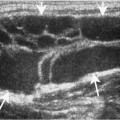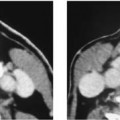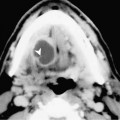Chapter 166 Cervical nodal enlargement is frequently encountered in patients with head and neck cancers. Nodal involvement is an important determinant of prognosis. The presence of lymphadenopathy reduces the prognosis by half. The carotid artery can be involved following advanced nodal metastasis with extracapsular spread (Fig. 166–1). Encasement of the carotid artery at the skull base may be due to perineural invasion along CN X. Apart from the primary disease, carotid invasion may be silent. However, patients may have hoarseness of voice or Horner’s syndrome indicating tumor involvement of the carotid sheath. Carotid encasement may be due to direct extension of the primary tumor or advanced nodal metastases. The presence of carotid encasement should also be evaluated in patients with neck recurrence.
Encasement of the Carotid Sheath
Epidemiology
Clinical Findings
Pathology
Treatment
Stay updated, free articles. Join our Telegram channel

Full access? Get Clinical Tree








